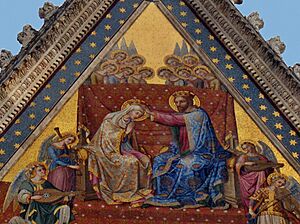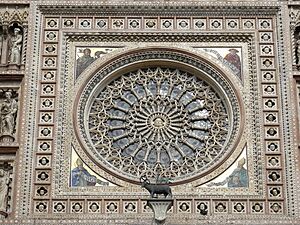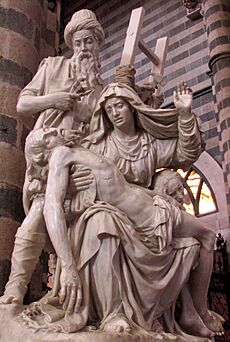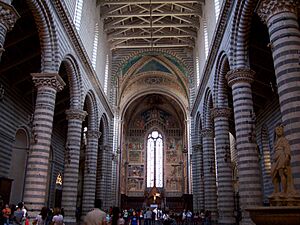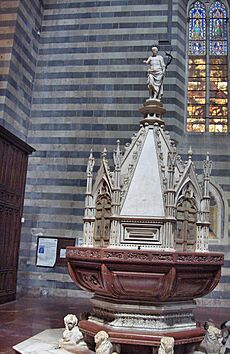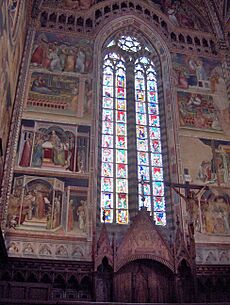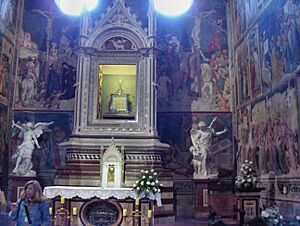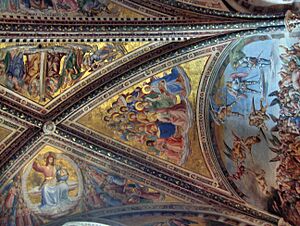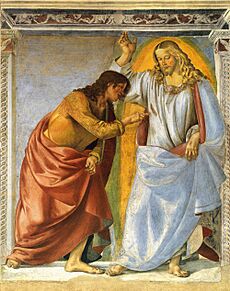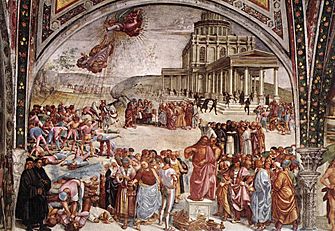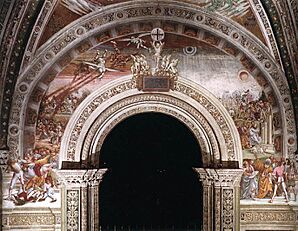Orvieto Cathedral facts for kids
Quick facts for kids Orvieto Cathedral |
|
|---|---|
|
Duomo di Orvieto
|
|
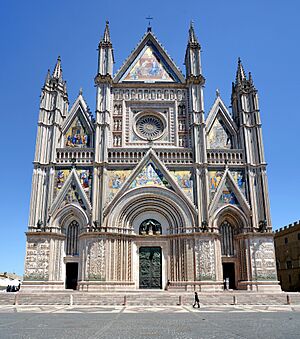
Façade of the cathedral
|
|
| Religion | |
| Affiliation | Roman Catholic |
| Province | Terni |
| Ecclesiastical or organisational status | Diocese of Orvieto-Todi |
| Status | Active |
| Location | |
| Location | Orvieto, Umbria, Italy |
| Architecture | |
| Architectural type | Church |
| Architectural style | Italian Gothic |
| Groundbreaking | 1290 |
| Completed | 1591 |
| Website | |
| http://www.opsm.it/ | |
The Orvieto Cathedral (also known as Duomo di Orvieto or Cattedrale di Santa Maria Assunta) is a huge Roman Catholic church. It was built in the 14th century and is dedicated to the Virgin Mary. You can find it in the town of Orvieto in Umbria, central Italy. Since 1986, it has also been the main church for the former Diocese of Todi.
The church was built because Pope Urban IV wanted a special home for the Corporal of Bolsena. This is a cloth stained with blood from a miracle that happened in 1263. A priest in the nearby town of Bolsena doubted that the bread he used for communion truly became the body of Christ. During a service, his Host started bleeding, staining the altar cloth. This cloth is now kept in the Chapel of the Corporal inside the cathedral.
The cathedral sits high up, overlooking the town of Orvieto, which is on a volcanic plug. Its front, called the façade, is a famous example of religious art. It has designs from the 14th to the 20th century. You can see a large rose window, shiny golden mosaics, and three huge bronze doors. Inside, there are two chapels with amazing paintings (frescoes) by some of Italy's best artists. These paintings show scenes from Judgment Day. The cathedral also has five bells from the Renaissance period.
Contents
Building the Cathedral
The construction of the Orvieto Cathedral took almost 300 years. Its design changed over time, starting in the Romanesque style and then becoming more Gothic. The first stone was laid on November 13, 1290, by Pope Nicholas IV. The first chief-mason, builder, was Fra Bevignate di Perugia. He followed a design by Arnolfo di Cambio, who also designed the Florence Cathedral.
The cathedral was first planned as a Romanesque church with a main nave and two side aisles. But when Giovanni di Uguccione took over, the design changed. It became more like the Italian Gothic style.
Building continued slowly until 1309. Then, a sculptor and architect from Siena named Lorenzo Maitani was put in charge. He had to fix problems with the building's strength, especially in the choir area. Maitani made big changes to the design. He made the church look more like Siena Cathedral. Both buildings are sometimes called "Siennese Gothic."
Maitani added flying buttresses to strengthen the outside walls. These supports later became part of the new transept chapels. He also changed the apse (the rounded end of the church) to a rectangular shape. He added a large stained-glass window. From 1310, he worked on the front of the cathedral, adding the bronze statues of the symbols of the Evangelists. He also designed much of the inside. Maitani died in 1330, and his sons finished his work.
Later, other famous artists worked on the cathedral. Andrea Pisano became the Master of Works in 1347. Then, in 1359, Andrea di Cione, known as Orcagna, took over. He is credited with the beautiful mosaic decorations and the large rose window. The Sienese architect Antonio Federighi added some Renaissance touches between 1451 and 1456. The final parts of the façade were completed by Ippolito Scalza in the late 1500s and early 1600s. Even with many different builders, the front of the cathedral kept a unified style.
The Cathedral's Front (Façade)
The Gothic front of the Orvieto Cathedral is one of the greatest artworks from the Late Middle Ages. Its design, with three pointed gables, is thought to be by Maitani. He was likely inspired by the Tuscan Gothic style of the Siena Cathedral and the plans for the Florence Cathedral.
The most striking part is the golden front. It is covered with large carvings (bas-reliefs) and statues. These statues show the symbols of the Evangelists (Angel, Ox, Lion, Eagle). Maitani and his team created them between 1325 and 1330. In 1352, Matteo di Ugolino da Bologna added the bronze Lamb of God above the central gable. He also added the bronze statue of Saint Michael on top of the left entrance.
The carvings on the piers (supports) tell stories from the Bible. These marble carvings from the 14th and 15th centuries were made by several artists and their workshops. Work on them started before 1310. They show:
- Stories from the Old Testament, like the Book of Genesis.
- The Tree of Jesse, with Old Testament scenes and prophecies about Redemption.
- Scenes from the New Testament, including events from the lives of Jesus and Mary.
- The Last Judgment, from the Book of Revelation.
Above these carvings are sparkling mosaics. They were made between 1350 and 1390, based on designs by artist Cesare Nebbia. These original mosaics have been replaced and redesigned over the centuries. Most of them show important moments from the life of the Virgin Mary. For example, from the "Nativity of Mary" on the lower right to the "Coronation of the Virgin Mary" at the very top.
In the middle of the mosaics is the large rose window. It was built by the sculptor and architect Orcagna between 1354 and 1380. In the spaces above the rose window are statues of the twelve apostles. On both sides, there are twelve Old Testament prophets, shown in pairs.
The newest parts of the decoration are the three bronze doors. These doors lead into the cathedral. They were finished in 1970 by the Sicilian sculptor Emilio Greco. They show acts of mercy from the life of Christ. Above them is a sculpture of the Madonna and Child, made by Andrea Pisano in 1347.
The side walls of the cathedral look different from the front. They are built with alternating layers of white travertine stone and blue-grey basalt stone.
Inside the Cathedral
The cathedral has a main nave with six sections (bays) and two side aisles. It is shaped like a cross. The inside was designed to feel open and spacious. Like the outside, the interior walls have alternating rows of basalt and travertine stone. These rows go up about 1.5 meters. Above that, the walls were painted with black and white stripes in the late 1800s.
The round columns also have alternating rows of travertine and basalt. Their shape and decorations changed as the cathedral was built. The alabaster panels in the lower parts of the aisle windows help keep the inside cool during hot Italian summers. The stained-glass windows in the upper parts are from 1886 to 1891.
The wooden roof was decorated in the 1320s. It was later heavily restored in the 1890s to its current look.
Near the left entrance, you'll find a large marble baptismal font. It has lion figures and detailed carvings. It was started in 1390 by Luca di Giovanni. Later, others added to it, including a red marble basin and an octagonal pyramid top.
Above the font is a fresco (wall painting) called "Madonna Enthroned with Child." It was painted by Gentile da Fabriano in 1425. This is the only original fresco that was saved when new altars were added in the 16th century.
At the beginning of the nave, there is a holy water font. It was sculpted by Antonio Federighi between 1451 and 1456.
Above the entrance to the Chapel of the Corporal is the cathedral's large organ. It has 5,585 pipes! It was first designed in the 15th century. Another important work by Ippolito Scalza is the large Pietà sculpture he made in 1579. It took him eight years to carve the four figures in this impressive marble group.
The Apse
The large stained-glass window in the apse was made between 1328 and 1334 by Giovanni di Bonino. The design was probably by Maitani. Above the altar hangs a large wooden crucifix, also thought to be by Maitani.
The Gothic wooden choir stalls were started in 1329. They were originally in the middle of the nave but were moved to the apse around 1540.
Behind the altar, there are many old frescoes dedicated to the life of the Virgin Mary. These paintings cover all three walls. They were created around 1370 by local artist Ugolino di Prete Ilario and his helpers. It took them about ten years to finish. This was one of the largest series of frescoes in Italy at that time. They have been restored many times over the centuries.
Chapel of the Corporal
The Cappella del Corporale is on the north side of the main crossing. It was built between 1350 and 1356. Its purpose was to hold the stained corporal from the miracle of Bolsena. From this chapel, the special container (reliquary) with the corporal is carried in religious parades. In this chapel, you can see relics from the Eucharistic miracle in Bolsena. Some people call it the miracle of Bolsena because that's where it happened. But the relics are kept here in Orvieto because the Pope was living here at the time.
The chapel has two sections and is covered with arched ceilings. It is closed off by a wrought iron gate, made between 1355 and 1364.
The chapel walls are covered with frescoes. On the left wall, they show the history of the Eucharist. On the right wall, they show other miracles involving bleeding communion bread throughout church history. These were painted between 1357 and 1363 by three artists from Orvieto. They were restored in the mid-1800s.
In the center of the chapel is the Reliquary of the Santo Corporale. This is a beautiful silver container with gold and colorful enamel. It holds the bloodstained corporal. This Gothic masterpiece was made by Ugolino di Vieri between 1337 and 1338. It shows 24 scenes from the life of Christ and eight stories about the corporal.
A Martyred Mayor
The cathedral also holds the tomb of St. Pietro Parenzo. He was appointed mayor of Orvieto in 1199 by Pope Innocent III. His job was to bring order back to the city. He was so successful that a group called the Cathars (who had different religious beliefs) murdered him in 1199. After his death, many people said that God granted their prayers when they asked for Parenzo's help at his tomb. Because of this, people from all over central Italy began to visit the Duomo on pilgrimage. Many miracles were reported, and Parenzo quickly became known as a saint.
His remains were moved to the cathedral after it was built. There is a small oval window in the altar where you can see the small box that holds them.
Chapel of the Madonna di San Brizio

This chapel was added to the cathedral in the 15th century. It looks very similar to the Chapel of the Corporal. Building this chapel (also called the Cappella Nuova or Signorelli chapel) started in 1408 and finished in 1444. It is closed off by two wrought iron gates.
Originally, it was just called the New Chapel. In 1622, it was dedicated to Saint Britius (San Brizio). He was one of the first bishops who brought Christianity to the people of Orvieto. Legend says he left them a painting called Madonna della Tavola. This painting shows the Madonna enthroned with the Child and Angels. It was painted by an unknown artist in the late 13th century.
Fra Angelico and Benozzo Gozzoli started decorating the chapel's ceiling in 1447. They only painted two sections: Christ in Judgment and Angels and Prophets. They then had to leave because Pope Nicholas V called them to work in the Vatican. The work stopped for about 50 years. Then, on April 5, 1499, Luca Signorelli was hired to finish the ceiling. He added scenes with the Choir of the Apostles, Doctors, Martyrs, Virgins, and Patriarchs.
The church leaders were very happy with Signorelli's work. So, they asked him to paint frescoes on the large curved walls of the chapel. He started in 1500 and finished in 1503. These frescoes are considered Signorelli's most complex and impressive work. He and his team spent two years creating a series of frescoes about the Apocalypse and the Last Judgment. They start with the Preaching of the Antichrist, then show the chaotic End of the World, and then the Resurrection of the Flesh. The fourth scene is a scary picture of the Damned taken to Hell and received by Demons. On the wall behind the altar, Signorelli shows the Elect being led to Paradise on the left and the Reprobates driven to Hell on the right.
- The Preaching of the Antichrist was painted shortly after the execution of Girolamo Savonarola in Florence in 1498. The Antichrist is shown being influenced by Satan. To make the scene feel more modern, Signorelli included portraits of famous people of his time. You can see young Raphael, Dante, possibly Christopher Columbus, Boccaccio, Petrarch, and Cesare Borgia. On the left, Signorelli painted himself and Fra Angelico.
- In the background, the Antichrist is thrown out of heaven by the archangel Michael. His followers are killed by a rain of fire.
- The End of the World is painted above the chapel entrance. Signorelli shows frightening scenes of cities falling apart and people running under dark skies.
- The Resurrection of the Flesh is Signorelli's study of the human body. He shows many different positions of people rising from the earth. Two angels in the sky blow trumpets to call them back to life.
- The Damned are taken to Hell and received by Demons is very different. Signorelli used his imagination to show the terrible fate and despair of the damned. He used naked human bodies to express agony, showing them tangled together and overpowered by demons.
- Frescos
Below these large paintings are smaller ones of famous writers and philosophers. They are shown watching the disaster unfold above them. These writers are said to be Homer, Empedocles, Lucan, Horace, Ovid, Virgil, and Dante.
In a niche on the lower wall, there is a Pietà painting. It shows the dead Christ with Mary Magdalen, the Virgin Mary, and two important Orvietan saints, S. Pietro Parenzo and S. Faustino.
Papal Palace
The Papal Palace is next to the right side of the cathedral. It was started in the mid-13th century when the popes moved to Orvieto to avoid conflicts in Rome. Pope Urban IV and Pope Martin IV both lived in the town and likely oversaw the first parts of this building. Pope Boniface VIII made the building larger. However, it was left unfinished when the popes moved to Avignon in 1309.
It remained a papal home until 1550. Then, it became the property of the cathedral. After using it as a residence for a while, it was turned into a museum in 1896. Today, it still functions as a museum. Inside, you can find information and items about the history of the cathedral and the town. You can see old artworks from the cathedral and pieces of the original building that were removed during later restorations. This includes paintings, special containers for relics, and the first plans for the cathedral's construction.
The ground floor of the building also has a museum dedicated to the Sicilian artist Emilio Greco. He created the cathedral's bronze doors in 1970. This museum displays many of his works, including drawings and sculptures for other large pieces. Some of his works are even in St Peter's Basilica in the Vatican.
Opera del Duomo Palace
Across from the cathedral is a large, grand building called the Palazzo dell'Opera del Duomo. It was built in 1359 to hold the cathedral's administrative offices. In 1857, it was expanded to create a museum on the ground floor. This museum houses Etruscan artifacts found around the city. Orvieto was once a major Etruscan capital. Next door to this building is the Claudio Faina museum. It holds a large collection of Etruscan art gathered in the 19th century by Count Mauro Faina.
See also
 In Spanish: Catedral de Orvieto para niños
In Spanish: Catedral de Orvieto para niños
- Italian Gothic architecture
- List of Gothic Cathedrals in Europe


